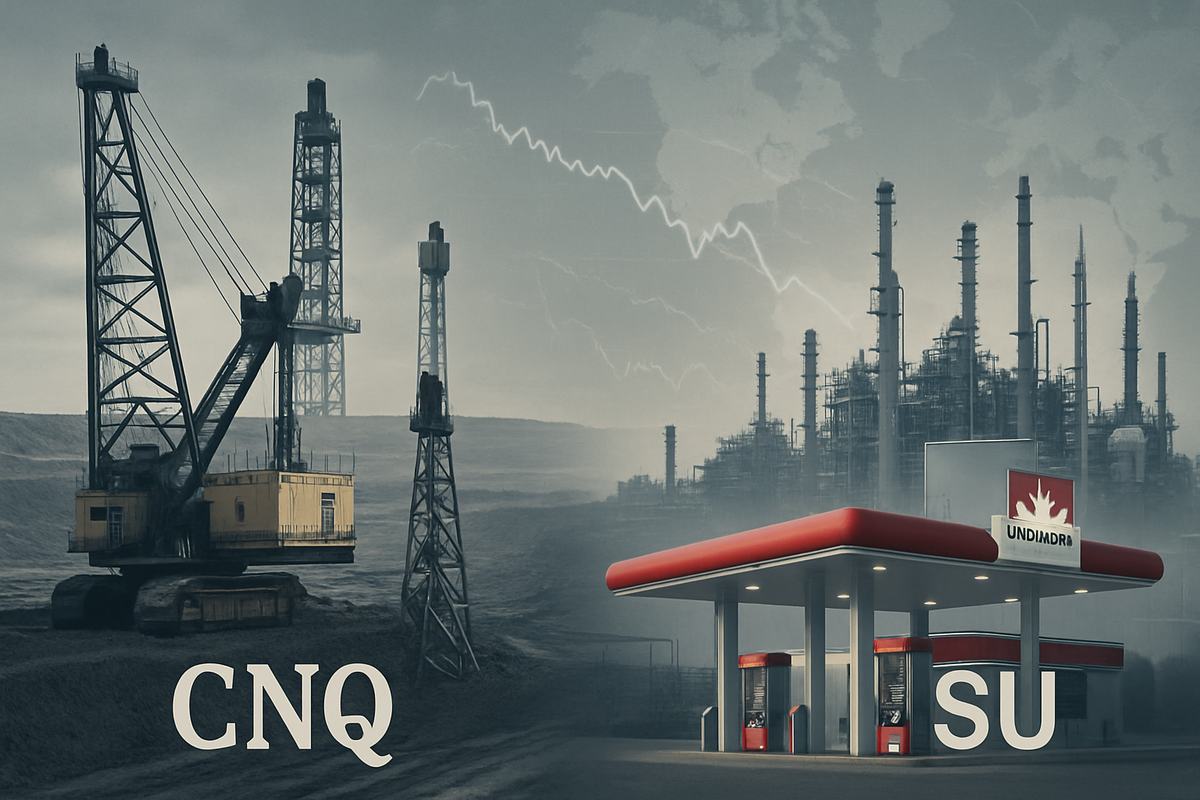
As global oil commodity prices experience a notable downward trend in October 2025, the Canadian oil and gas sector finds itself navigating a complex landscape. Concerns over an escalating global oversupply, coupled with persistent geopolitical tensions and a decelerating demand outlook, are exerting significant pressure on crude benchmarks. For investors eyeing the robust Canadian energy market, the critical question emerges: between two titans, Canadian Natural Resources (TSX: CNQ, NYSE: CNQ) and Suncor Energy (TSX: SU, NYSE: SU), which presents a more compelling buying opportunity in this challenging environment?
This article delves into the current state of the oil market, scrutinizes the unique profiles of CNQ and SU, and analyzes their potential trajectories, offering insights for investors seeking to capitalize on, or hedge against, the prevailing market dynamics.
Global Headwinds and Canadian Resilience: A Market Under Pressure
The global oil market is currently characterized by bearish sentiment, with both West Texas Intermediate (WTI) and Brent crude futures signaling a period of sustained weakness. As of mid-October 2025, Brent crude oil futures are hovering around $61.02 USD/bbl, marking a significant decline of nearly 10% over the past month and over 16% year-over-year. Similarly, WTI crude has seen substantial drops, testing initial support levels and showing potential to fall further towards $55.20. This downturn is primarily driven by growing signs of oversupply, exacerbated by increased U.S. crude inventories and revised forecasts from the International Energy Agency (IEA) and the U.S. Energy Information Administration (EIA) predicting a global oil surplus extending through 2026. Geopolitical factors, including renewed U.S.-China trade tensions and the potential for increased Russian supply, further dampen demand expectations.
Against this backdrop, the Canadian oil and gas sector presents a mixed picture. Production has reached record highs, with Canadian oil supply hitting 6.5 million barrels per day (MMbpd) in July 2025. However, this increased output is shadowed by uncertainties surrounding market access, rising operational costs, and the lingering impact of policy decisions. While the new Liberal minority government, led by Prime Minister Mark Carney since April 2025, has shown a more conciliatory stance towards the industry, acknowledging its economic importance and discussing support for pipeline modernization and LNG exports, existing anti-hydrocarbon policies continue to pose challenges. The IEA's forecast of a record global oil surplus in 2026, coupled with slowing demand growth, is expected to weigh heavily on Western Canadian producers, whose oil is often considered more expensive to extract compared to international counterparts.
Canadian Energy Giants: A Tale of Two Strategies
In this volatile market, Canadian Natural Resources (TSX: CNQ, NYSE: CNQ) and Suncor Energy (TSX: SU, NYSE: SU) stand out as key players, each with distinct business models that dictate their resilience and potential returns.
Canadian Natural Resources (TSX: CNQ, NYSE: CNQ) operates as a pure-play oil and gas production company, making its financial performance highly sensitive to fluctuations in commodity prices. With a diversified portfolio encompassing crude oil, natural gas, and natural gas liquids across Western Canada, the North Sea, and offshore West Africa, CNQ is renowned for its operational scale, boasting 1.36 million BOE/day production as of March 2025. The company's latest quarter (July 2025) reported robust net profits of $2.5 billion and revenues of $10.9 billion, surpassing expectations. CNQ offers a compelling dividend yield of approximately 5.4% and has a commendable track record of consistent dividend growth over the past decade, appealing strongly to income-focused investors. Its strategic focus on reducing net debt, targeting $16.7 billion by the end of 2025, along with its extensive reserve life of 33 years, positions it to capitalize significantly when oil prices rebound.
Suncor Energy (TSX: SU, NYSE: SU), in contrast, is an integrated energy company. Its operations span oil extraction, refining, and a vast retail network, including Petro-Canada fuel stations. This integrated model provides a degree of insulation from crude price volatility, as strong refining margins can often offset declines in crude prices. Suncor reported net earnings of $1.7 billion in its most recent quarter (July 2025), exceeding expectations, and achieved record oil production and refining throughput in 2024. The company has made significant strides in operational efficiency under new management, achieving a breakeven price (including dividend) in the mid-$40s US per barrel. Suncor offers a dividend yield of around 4.4% and has successfully achieved its net debt target of $8 billion as of March 2025, committing 100% of excess funds to shareholder returns, primarily through share buybacks. This strategy appeals to more conservative investors seeking stability and consistent shareholder value.
The choice between CNQ and SU largely hinges on an investor's risk appetite. CNQ, with its pure-play production model, offers higher leverage to rising oil prices and a more aggressive growth profile, making it a potential "winner" if prices recover swiftly. However, this also exposes it to greater downside risk during prolonged periods of low prices. Suncor, through its integrated structure, provides greater stability and less volatility, making it a more suitable option for those prioritizing steady income and capital preservation in a challenging market.
Broader Implications and Industry Trajectories
The current downward pressure on oil prices and the ongoing comparison between companies like CNQ and SU fit into broader industry trends marked by increasing supply, moderating demand growth, and the persistent specter of climate transition risks. The IEA's and EIA's forecasts of a global oil surplus extending into 2026 underscore a fundamental shift in market dynamics from the undersupply conditions seen between 2021-2024. This oversupply scenario has significant ripple effects, notably on the commodity-linked Canadian Dollar (Loonie), which tends to weaken with falling crude prices, impacting Canada's overall economic outlook.
Regulatory and policy implications also play a crucial role. While the new Canadian government has shown a more pragmatic approach to the oil and gas sector, the long-term commitment to climate targets and the existing "no new pipelines" legislation continue to shape investment decisions. A June 2025 report warned that Canada's continued expansion of oil and gas production risks stranding billions in future investment, with up to 66% of capital investments potentially becoming uncompetitive under a 1.5°C climate scenario. This highlights a critical challenge for Canadian producers, whose cost structures are often higher than international competitors. Historically, periods of oversupply have led to industry consolidation, increased focus on cost efficiency, and diversification efforts, suggesting that companies with robust balance sheets and integrated operations might weather the storm more effectively.
Navigating the Future: What Comes Next
In the short term, the market anticipates continued volatility in oil prices, with WTI potentially testing lower support levels. Geopolitical developments, particularly regarding U.S.-China trade relations and the resolution of conflicts that could impact global supply, will remain critical drivers. For Canadian producers, the persistent oversupply scenario and potential for deflated returns will necessitate strategic pivots.
Both CNQ and SU are likely to continue their focus on capital discipline and shareholder returns. CNQ's emphasis on debt reduction and its strong dividend growth history position it to maintain investor confidence even in a tough market, provided its operational efficiency remains high. Suncor's integrated model offers a natural hedge, and its commitment to share buybacks after achieving its debt target suggests a robust approach to returning value to shareholders, potentially making its stock more resilient. The long-term outlook for the Canadian sector will depend on the successful development of new market access, such as LNG facilities, and the industry's ability to innovate and reduce its environmental footprint to align with global climate goals. Companies that can demonstrate low-cost production and a clear path to sustainable operations will be best positioned for long-term success.
A Prudent Path Forward: Key Takeaways for Investors
The current environment of falling oil prices and a projected global oversupply presents a nuanced challenge for investors in the Canadian energy sector. The comparison between Canadian Natural Resources (TSX: CNQ, NYSE: CNQ) and Suncor Energy (TSX: SU, NYSE: SU) underscores the importance of aligning investment decisions with individual risk appetites and strategic objectives.
CNQ, with its pure-play production model and higher dividend yield, offers greater upside potential should oil prices recover strongly, appealing to growth-oriented investors willing to accept higher volatility. Its scale, long reserve life, and focus on debt reduction provide a strong foundation. Suncor, as an integrated energy company, provides a more stable and less volatile investment, making it attractive to conservative investors seeking consistent income and capital preservation, particularly given its improved operational efficiency and commitment to shareholder buybacks.
Moving forward, investors should closely monitor global oil price movements, particularly WTI and Brent benchmarks, and track company-specific metrics such as debt levels, operational costs, and shareholder return policies. Geopolitical developments and evolving regulatory landscapes in Canada will also be crucial factors influencing the sector's performance. While the immediate outlook for oil prices appears bearish, the resilience and strategic agility of these Canadian energy giants will determine their long-term viability and attractiveness as investment opportunities.
This content is intended for informational purposes only and is not financial advice






